Imprimer
Articles liés
Artistes
Ismaïl Bahri
Dear Olivier, It’s the month of August and I’m writing to inform you about new experiences begun during and after the FID (Festival International du Documentaire). These experiences grew directly out of the discussion I had there with you and other people. They were also activated in part by the exchange that occurred with the public on the subject of the work undertaken by the Maison de la Région. It seems to me that the FID experience helped me understand the possible links between my research and cinema. This relation has been active for quite some time, but I only intuited it. You’ll see that my ideas gravitate around questions we already touched on in our previous exchanges and that they can be considered as extensions to earlier videos such as Orientation and Dénouement in particular. All of the videos dialogue together and I feel a greater and greater need to conceive of and work with them as linked elements, like the wheels of a great cinematic filming device.
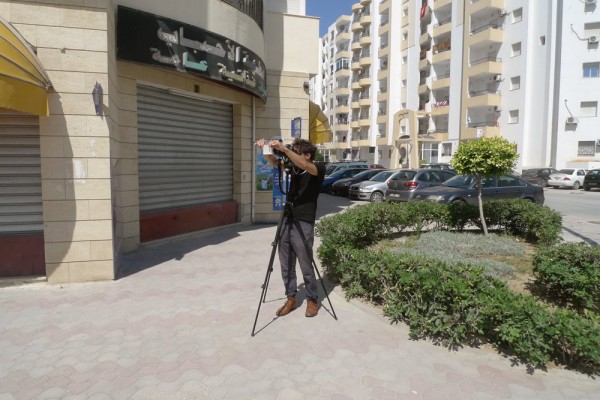
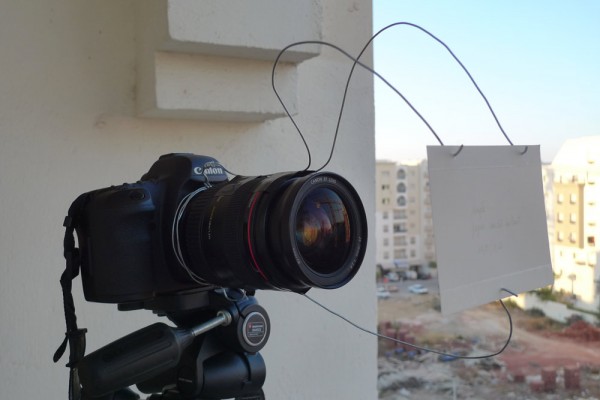
The device
A paper shutter is grafted on to the camera lens. Iron wires hold it in position a few centimeters from the lens. The shutter or mask is cut to the exact proportions of a 4/3 and just lets you see what is occurring at the edges; it almost totally obstructs the field of vision. The paper functions as a shutter but also as a screen. By a surface effect this screen has the form of a white halo, similar to a projection without film. It hides as much as it shows: it leads the eye to the margins and shows the premises of the off-camera scope.
Focus is adjusted to the furthest element in the field . A tension is thereby created between this jump towards the horizon and adhesion to the screen. It’s a simple way to impede mechanics: pull out to the furthest point so as to trouble the surface image. Looking at the resulting videos, we swing between the illusion of a light and the reality of a darkening. It’s a dazzling form of shutter. An obstruction of light giving the illusion of a flash of light, of an overexposure that troubles the nature of the screen. The surface of the video image becomes confused with the white surface of the image.
The device is extraordinarily simple and produces an image that is not initially revealed. I think it brings into question the visual uncertainties linked to the mechanized magic of light, to cinematographic scintillation (surface vibration, film, scintillating photogram…) It seems to me that we find here the same will to make a digitalized image tremble via the interface of an elementary intercessor, in this case the sheet of paper.
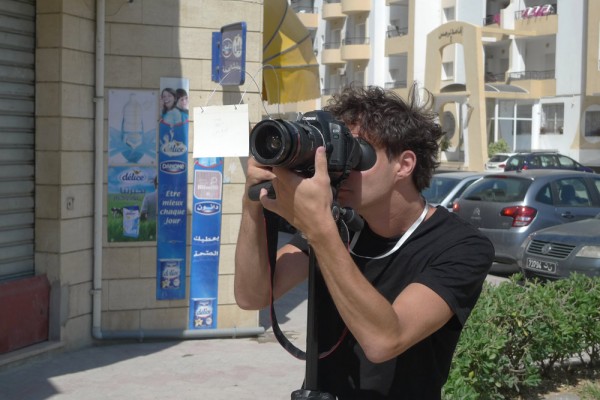
Relation to film
As I told you at the FID, I believe it is these elements already present in my work that I want to develop in the coming months. I want to experiment with this dynamic. I would like to deepen the relation to film already present in my work. To explore the idea of an archeology of film and the use of elementary intercessors through the exploration of different issues linked to the operations and mechanics of cinematography. For example, Dénouement is an attempt to replay questions of depth of field as much as Orientations, which also explores the lens, the viewfinder, detail and off camera fields. Attraction is a sort of inverted camera obscura, Film revisits in a sort of magic theater the unrolling of a reel, the kinetics of images in the same way that Ricochet captures a recording without persistence. And now shuttering, projection, screen: the question of luminous magic. I realize that each of these experiences helps define the lines of a great cinematographic filming apparatus. And it is the constituent elements of this device that I want to continue to dissect—the way you take apart a machine—so as to put it together again through the knowledge gleaned from my diverse experimentations.
Reports on experience
The device has not found its definitive form. Up until now, I’ve used it to film different subjects: landscapes, construction sites, street scenes, demonstrations. Possibilities abound. The most interesting experiences turn out to be saturated scenes, or the moments when a visual field is filled in all its depth.
Landscapes and shutter
The landscape scenes tested at Saint-Etienne in early July interested me because I had used a ‘cache’ or shutter attached at its top. The cache was mobile and functioned like a shutter activated by the wind. The experiment is supported by what we already spoke of concerning the recourse to elementary intercessors, in this case the wind, similar to Simon Quéheillard’s work. The wind as driving energy allows for a dynamic of revelation and shuttering of an image. Another point: the forward and backward movement of the shutter increases in volume and creates a surface disturbance. Again, what interests me is the variation of colors and luminous pulsations created by this swinging effect. When the videos are seen as a series, one beside the other, they accentuate the pulsing variations and lead us to consider the question of the horizon. My obsessions resurface here: working on the furthest point via a surface effect. But this remains to be developed.
Blank filming
Another experiment was conducted in Tunis in July, at a time when the country was going through a period of trouble. I filmed the procession that was accompanying the body of Mohamed Brahmi, an assassinated Tunisian political figure from the opposition, to the cemetery. Thousands of people had gone out into the streets to demonstrate. This experience interested me for several reasons. First, the field of vision, completely saturated with people and movements, created tension in the image. I have the impression the device activates the flux produced by these moving forms, in particular through the contrast created between the vibrating fixity of the white frame and the mobility of the bodies moving past. I was also interested by the superposition of forms in depth. In this sense the shutter covers up bodies that are naturally disappearing one after the other.
At the beginning, what interested me about filming this demonstration was the flow of life, the effect of the mass. I had in mind images of crowd scenes in film : the first Lumière films, films by Griffith and Eisenstein. But once I was in position I realized that a tension was being created between the historic event and the discharged—emptied—image produced by the device. Many people in the procession took me for a journalist and wondered what the apparatus was. For example, a woman who passed behind me said « don’t miss anything ! », implying « film the event, keep it in memory for the community». You could say this was just a simple anecdote, but from these words the shift, or the off kilter quality of the experience comes to the fore, since the idea is less to capture the event than to miss it. I am making a blank film. And the idea of a blank film is important because it presupposes a film emptied of its content, a film haunted by its absent images. That’s it. Here, there is no film other than the one unfolding elsewhere, projected beyond the screen.
This ambiguous image of a blank film explores the twist of a contact that is not there. To set out to film in the midst of a crowd, in contact with an event, implies establishing a precise distance, whether in terms of the subject to be filmed, the world, or the context. Having recourse to physical intercessors (paper, wire, ink) activates the distance while at the same time clearly linking the camera to the subject being filmed. The wire in Dénouement establishes a long distance contact when the paper screen creates a surface disturbance on a depth. I have the feeling that it is precisely at the point of tension between contact and distance that the truly cinematographic instant occurs, at the edge of film and on the scale of this surface disturbance a haunted memory of cinema survives. This tension operates on another level ; between the small scale and the mass, between the fragment of paper, only a few centimetres wide, and the swarming crowd. The work of framing (and of the frame in the frame) adds to—by a capillary effect—aggregate and fragment in the same image.
And to come back to the question of light, it seems to me that the capturing device interrogates the relation between the natural saturation of the filmed event and the white overexposure of the image. Which gives rise to the following question that I would like to explore with you : is using luminous overexposure a way of escaping media overexposure ? It’s difficult to say at this early stage of the experiment, but I had the impression that I had perhaps found a way to film these scenes that I find so difficult to frame (because they have been seen so often over the last two years.) I have the impression that framing cannot be done without having recourse to retreat, to a distancing.
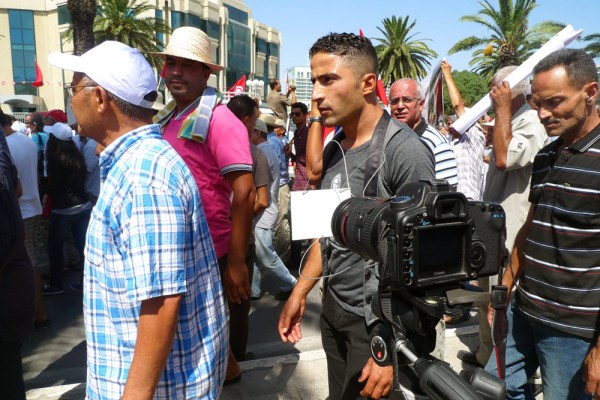
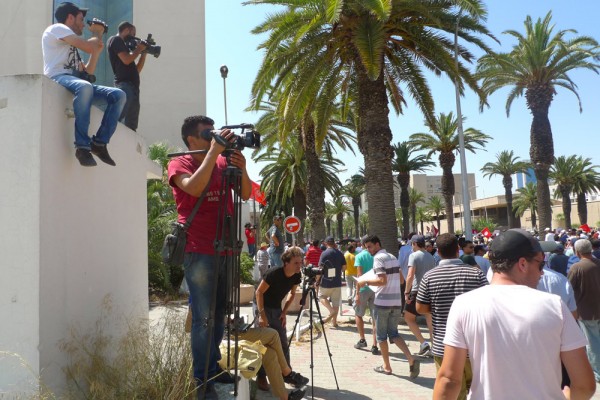
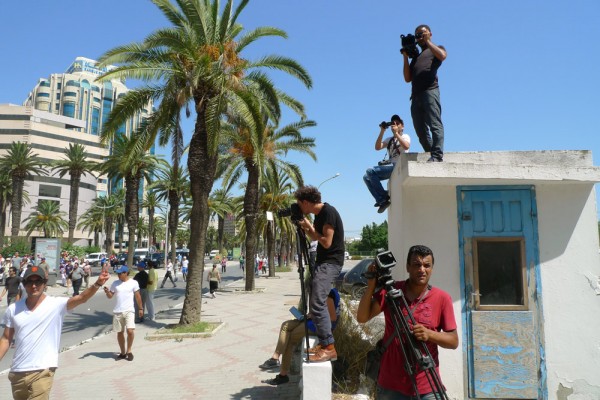
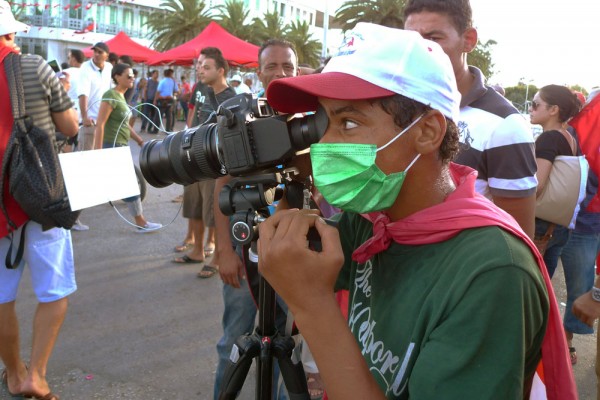
Olivier, I’m writing to you following new developments that have refined earlier experiences. I filmed another demonstration and what seems important to note this time is that I positioned myself in the middle of the crowd and not at its edges. I framed people mid-body, at hip level. I found it more judicious to place myself at the heart of the movement, like a stone enveloped in flux. Filming from the middle of the crowd accentuated the swarming effect and allowed me to catch the shadows of people passing behind me between the camera and the subject being filmed. At other moments as people milled about they sometimes bumped into the ‘cache’, or paper shutter and made it tremble. The double conjunction of shadows and trembling contributed, I believe, to the unveiling of the device and accentuated the filmic character of a screen whose nature we finally guess.
This experience made the importance of one of the elements of the video even more apparent: the covering of forms. In film and Dénouement, there was a question of folding and deployment or unfolding; here it is a matter of covering in multiple layers. Folding and covering interest me because they give form to a complex image, taking the time to open out over different periods of time and in different spaces.
And here again I was disturbed at work when a demonstrator passing by made the following comment that rang in my ears like a saying: « you need white (or blank) to make a semblance» (in French: vous avez besoin du blanc pour faire semblant). Semblant (semblance, pretense, sham, appear…) and sans blanc (without white, without blankness) are homonyms in French. The phonetic wordplay curiously anticipates the idea of an emptied film, of a filmic shell. Faux-semblants (false pretenses) linked to the idea of blankness or emptiness emphasizes the artificial nature of a film take without filming. Which in turn reinforces the idea of using these videos as a semblance of cinema.
Ellipses
I also filmed landscapes using the pivoting shutter which this time was set in motion by the wind. The luminous palpitation activated a form of intermittence. The most interesting moments seemed to me to occur when people entered into the frame. Their discontinuous apparition precipitated a potential and partial narrative. Held in check by its premises, the narrative is born by an effect of ellipsis, in a pattern described by leaps and swings. These swings can occur inside each screen and between screens—if we imagine a series of videos reconstructing the landscape. They would create an effect of allusion by loose suture.
As I’m writing the idea comes to me of chronophotographic intuition: in the jump between two images there is the blink of an eye, the obstruction separating two stations of movement punctuates progression by absence. And what I’m hoping to achieve by the interference of these empty blanks in the continuity is to make the video image tremble by what I would call a ‘photogrammic’ palpitation.
Finally, to come back to the idea of elementary intercessors we spoke of during our exchanges at the FID, I believe in this instance the elementary notion takes on a double sense. I’m thinking of the simplicity of the material used (paper) and the basic relation of the device functioning with natural elements. In this case the wind sweeping across the landscape and causing the image to palpitate. It is the visible movements of air that, shown in this way, accentuate the cinematographic trembling. The landscape and the bodies enveloped by the elements—activated by the wind that haloes them—become the subjects of a film that the paper shutter makes perceptible.

